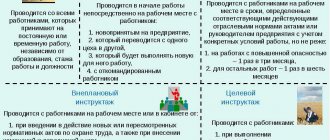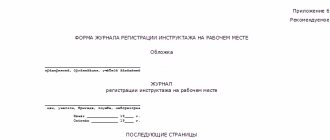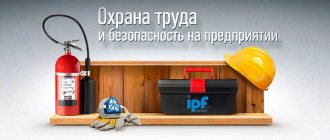Initial instruction: what is it?
The primary instruction is the one provided by the employer to the employee before starting work in a new place. The obligation to carry it out is established by Art. 225 Labor Code of the Russian Federation.
The briefing is devoted to familiarization with labor safety rules, demonstration of safe working methods and first aid techniques. It is held for employees:
- Newly hired by the employer (regardless of the form of this work).
- Transferred to a new workplace or to perform a new job.
- Those working for the employer temporarily: those sent to him from other employers or undergoing internship.
The procedure according to which the initial briefing is carried out is determined by two documents:
- Resolution of the Ministry of Labor of the Russian Federation, Ministry of Education of the Russian Federation dated January 13, 2003 No. 1/29;
- GOST 12.0.004-90.
Its basis is the employee’s familiarity with:
- General information about the nature of production, the purpose of the workplace, the equipment, tools, and materials used on it and near it.
- Factors that may be considered dangerous or harmful for this place.
- Rules of conduct in the workplace and other premises.
- Basic rules for safe work on existing equipment.
- Principles of preparation for work and completion of it.
To learn how to assess the danger or harmfulness of working conditions, read the material “Dangerous and harmful production factors (list).”
The training may also cover other issues related to occupational safety and health. For different categories of employees, the lists of questions are different, so the employer may have several options for the initial training program at the workplace.
When conducting instruction, special attention is paid to employees of those positions who, by the nature of their work, deal with mechanisms and equipment. For them, initial instruction is mandatory. Employees whose functions are not related to the use of tools, equipment, and materials may be exempt from instruction by the decision of the employer’s manager. Persons working with computers and office equipment are not included in this category.
ConsultantPlus experts explained how to organize the work of the labor protection service in practice:
Get trial access to the K+ system and go to the HR Guide for free.
An approximate list of the main questions of initial briefing (according to GOST 12.0.004-90):
- General information about the technological process and equipment at a given workplace, production site, or workshop. The main dangerous and harmful production factors arising during this technological process.
- Safe organization and maintenance of the workplace.
- Dangerous areas of a machine, mechanism, device. Equipment safety equipment (safety, braking devices and guards, locking and alarm systems, safety signs). Requirements for the prevention of electrical injuries.
- The procedure for preparing for work (checking the serviceability of equipment, starting devices, tools and devices, interlocks, grounding and other protective equipment).
- Safe working practices and methods; actions in the event of a dangerous situation.
- Personal protective equipment at this workplace and rules for their use.
- Scheme of safe movement of workers on the territory of a workshop or site.
- Intrashop transport and lifting equipment and mechanisms. Safety requirements for loading and unloading operations and transportation of goods.
- Typical causes of accidents, explosions, fires, cases of industrial injuries.
- Measures to prevent accidents, explosions, fires. Responsibilities and actions in case of an accident, explosion, fire. Methods of using fire extinguishing means, emergency protection and alarm systems available on the site, and their locations.
You see, nothing superfluous! Just what the worker needs to know. Well, this is of course just an approximate list. I would add more methods of first aid here, combine paragraphs 9 and 10 into one, combine paragraphs 1-4 into one, remove “actions in the event of a dangerous situation” from paragraph 5, since this duplicates paragraph 10. Well, this so, little by little.
The purpose of the program, in essence, is to prevent the person conducting the training from forgetting what instructions the employee should read.
There are no more requirements for writing a labor safety briefing program other than those that I have listed. This means that the program can be presented in any form.
I would like to show a version of the initial training program at the workplace, using the example of an operator producing basalt-plastic reinforcement.
Who conducts the initial briefing?
Persons who have undergone special training in labor protection that meets the requirements of legislation and internal regulations are allowed to carry out initial briefing. This could be either the new employee’s immediate supervisor or an occupational safety engineer. More often this is done by the immediate supervisor, guided by the initial training program at the workplace.
Instruction can be carried out either individually or for a group, but in any case it is accompanied by a demonstration of safe work techniques and testing of the knowledge acquired by the employee. The fact of implementation is recorded in a special journal or personal occupational safety training card and is noted with the signatures of the instructor and employee.
For other types of safety briefings, read the material “How to conduct a safety briefing (nuances)?”
Purpose of the enterprise
Induction training is carried out with:
- newly arrived (hired) employees,
- citizens who arrived at production as business travelers;
- employees carrying out their activities under a fixed-term or civil contract;
- persons transferred to another position within the same enterprise.
The purpose of conducting introductory training on labor protection is:
- informing the organization's employees about the features of the organization's production process, the technology and equipment used in order to avoid disruption of the process and equipment failure;
- preventing injuries at work and harm to production employees;
- prevention of the negative impact of the specifics of production (working with harmful and dangerous elements of production) on employees, thereby preventing injuries;
- peculiarity of working with hazardous substances and mechanisms.
To achieve these goals, responsible persons develop special induction programs taking into account the specifics of the enterprise and the characteristics of the production process. After development, the programs are approved by order.
Training program and its sample
Each employer develops the program according to which initial training is carried out independently, based on their specific working conditions and guided by the list given in Appendix No. 5 to GOST 12.0.004-90. This list, in addition to information about the production process, equipment and work methods, includes the rules:
- Use of personal protective equipment.
- Fire and accident prevention.
- Behavior in situations of danger or accident.
A sample of the initial workplace training program can be seen on our website.
Who needs instruction?
Categories of workers who need training.
Absolutely all new employees undergo training, including the following groups:
- temporary work, such as seasonal harvesting of vegetables from fields;
- part-time workers;
- employees who work from home but use employer equipment;
- employees transferred from one structural unit to another;
- students in practice;
- seconded employees who arrived to the organization;
- as well as other persons if they are on the employer’s premises or participate in production processes.
The employer has the right to exempt from training. But in compliance with the regulations:
- It is necessary to identify groups of employees who do not work with equipment and do not use materials and raw materials;
- Write down a clear list of such positions and professions;
- Pin it to a local document;
- Assign him all the necessary details.
Results
Organizing initial training for a new employee before starting work is the responsibility of the employer and is aimed at ensuring that the employee complies with the rules of conduct aimed at preventing the occurrence of situations that are dangerous both to the life and health of the employee and to the safety of the employer’s property.
You can find more complete information on the topic in ConsultantPlus. Full and free access to the system for 2 days.
Who conducts the briefing
Training is required.
The head of work or a structural unit is responsible for his wards. This means that the responsibility falls on his shoulders to instruct and teach the basics of safe work to his team.
To accomplish such an important mission, the instructor must be trained himself. The training program lasts 40 hours. It could be:
- course at the training center;
- training within the organization.
Everything is clear with the training center. We choose an organization, check for a license, fill out an application, pay and go to improve our qualifications. What about internal training?
The main condition is the presence of a special qualified commission at the enterprise. Its members study at the training center unconditionally. Otherwise, the commission will be illegitimate.
Next you need to develop:
- training program;
- lecture material;
- tickets.
Referral to training within the organization is formalized by order/instruction. And the exam is based on a standard protocol. As a result, each student receives a certificate.
Not unlimited, another knowledge test after 3 years. There is an interesting nuance about where to get funds for the training of commission members. The answer is to apply to the Social Insurance Fund to finance preventive measures to reduce occupational injuries.
The amount of subsidies depends on the taxes paid to the budget for compulsory accident insurance.
There are deadlines for filing such an application - no later than August 1. We also must not forget that the expenditure of the funds received will need to be reported to social security.
Registration log - sample filling, storage period
Each company manager is required to draw up a report on the training of his employees. For this purpose, a special journal is created in which all data on the training of each employee is entered.
How to fill out the introductory briefing logbook
The logbook is filled out as follows:
- The title page should contain basic information about the company. In the lower right corner is written the start date of the journal, as well as the end date of entering data into it.
- The following pages are filled out in the form of a table. Each table consists of seven columns:
1. Date—the date the employee completed the training is indicated here. 2. Full name of the employee who completed the training. 3. Year of birth. 4. The position of the person undergoing training. 5. Full name of the person responsible for conducting the induction training. 6. Signature of the employee who conducted the training course. 7. Signature of the employee who completed the training course.
A completed log of induction training for employees of an organization must be kept for ten years. After which a new log is filled out.
The introductory briefing registration form can be downloaded here.
For whom is initial training on labor protection required?
Primary training on labor protection is necessary for workers:
• large, medium and small companies of all areas of activity, educational, trade institutions, hospitals, offices of companies and firms; • employed by individual entrepreneurs who use hired labor; • working remotely, if the employer provides them with equipment or machinery or recommends its use to perform specific work; • working from home using equipment or materials provided by the employer;
as well as pupils and students:
• who will begin educational, production, and any other practical activities; • before performing each practical task that is new to them during laboratory and practical classes.
Initial briefings on labor protection, samples of which are kept by those responsible for instructing subordinate employees, are mandatory for:
• workers who move to a new place; • employees who have recently been employed and have undergone induction training; • workers who will work in additional professions (for example, a conveyor operator, if necessary, will replace a repairman). At the same time, instruction alone is not enough - appropriate professional training must be carried out; • seconded, temporarily employed, seasonal workers; • employees of contractors and subcontractors who will perform work simultaneously with the main personnel of the customer or work in areas temporarily transferred to their disposal.
This instruction is read to workers by their direct supervisor. Before this, he must undergo full training in all occupational safety issues raised during the briefing and have a valid occupational safety certificate. This obligation is fixed by order.
https://youtu.be/B_Il3LoX230
How does induction training differ from other types?
- Induction briefing, unlike other types of briefings, is carried out by a responsible person appointed by the head of the enterprise.
- All newly hired employees are required to undergo this training, regardless of what knowledge they have.
- All data on the completion of the introductory briefing is recorded in a special logbook.
- Induction training is carried out after the employee is hired for the position.
- During the induction training process, the employee receives the general rules of the work process at the enterprise.
Watch also the video on types of briefings:
Useful articles:
Who can be exempted from initial training at the workplace?
Practical work 14 Question number Correct answer Practical work No. 15 When does an employment contract come into force? 1. From the date of its signing. 2. From the day the employee is actually admitted to work. 3. From the date specified in the employment contract. 4. In all the above cases. What is the duration of leave without pay for working disabled people? 1.
Up to 14 calendar days. 2. Up to 35 calendar days. 3. Up to 60 calendar days. Who is exempt from on-the-job training? 1.
An employee with at least 3 years of experience in his specialty. 2. An employee moving from one unit to another, if the nature of his work and the type of equipment on which he previously worked did not change.
3.
Who conducts it?
Persons appointed by order of the organization and responsible for labor protection are allowed to conduct induction training. They must have previously completed an appropriate training course. As a rule, they are the heads of workshops or heads of departments where the employee enters.
In large organizations and industrial enterprises there are services whose employees undergo an extended course on labor protection. They are responsible for all documents and regulations that are created and implemented at the enterprise in this area. They are the ones who are entrusted with conducting briefings, including initial ones.
It is permissible to conduct introductory occupational safety classes, both individually and in groups. The second option is more often applicable to groups sent to work in an organization or trainees.
What is induction training
Induction training is mandatory for every newly hired employee, regardless of position and rank. Those coming to work include:
- newly hired employees;
- recovered after dismissal;
- those arriving on a business trip;
- trainees;
- employees from other organizations performing any activities on the territory of the organization.
A person who comes to a new place is in a position where many circumstances are “new” to him, which should not affect the quality of his work, but mainly the safety during its performance. During induction, a new team member (alone or together with colleagues in the same position) should gain an understanding of:
- the enterprise itself;
- your personal or collective workplace;
- internal regulations;
- discipline requirements;
- other important features.
FOR YOUR INFORMATION! Induction training is a one-time procedure. It does not need to be repeated for internal transfers or leave. But if a person quits and then returns, induction training is necessary, as for a “newbie”.
When is it held?
Initial briefing should be carried out with employees before starting independent activities:
- newly hired by the organization, regardless of the nature of the work;
- temporarily working for a period of business trip or internship;
- transferred to another area of work associated with harmful, dangerous working conditions, or other significantly changing work within the framework of labor protection.
Instruction is required for every employee hired on a permanent or temporary basis. The manager has the right to approve the list of persons who do not have to undergo it. This often applies to office workers, whose work does not involve exposure to negative factors. However, if they violate labor safety rules, responsibility rests with the employer.
Instructions for conducting induction training
Such instructions are developed in accordance with the resolution of the Ministry of Labor and Social Development of the Russian Federation, as well as the Ministry of Education. The relevant document is approved by the head of the company.
Conducting induction training upon hiring
The instructions include the following sections:
- Basic information about the company - company name, address, head of the organization, etc.
- The rights and obligations of an employee - such points are established in accordance with the Labor Code.
- The rights and obligations of the employer are also prescribed on the basis of the Labor Code.
- Sanctions for non-compliance with labor discipline - here are specific examples of violations, as well as sanctions applied to the violator.
- Employee incentives - establishing points at which company employees can be awarded an additional bonus or gratitude.
- Labor regulations - establishing working hours, as well as time for rest and lunch.
- Receiving benefits and various compensations are established in accordance with the Labor Code. In addition, the head of the organization can, at his discretion, introduce additional incentives to his employees.
- Responsibility for violation of the work routine - sanctions applied to employees who violate the work routine of the enterprise are prescribed here.
- Ensuring labor protection and safety of the employee in the workplace - all the employee’s responsibilities are spelled out here to ensure safety during professional activities.
- General rules of conduct for the enterprise.
- Methods for preventing accidents in the workplace.
- The procedure for issuing personal protective equipment, as well as their service life.
- The procedure for conducting investigations of accidents that have occurred.
- Implementation of fire safety measures, as well as rules of conduct in case of fire.
- Rules for first aid.







